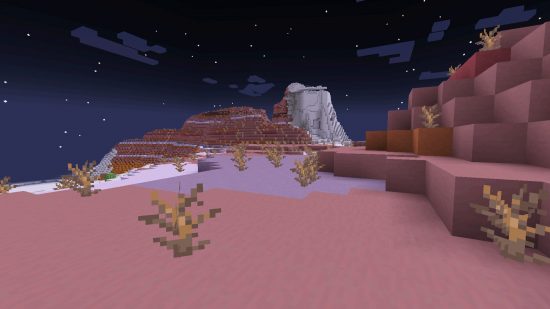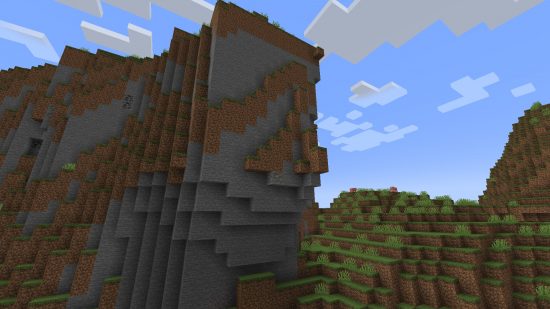Minecraft biomes are vast, varied, and full of things you definitely need. As you randomly generate each world, there are never any guarantees about where you’ll find the Minecraft biome you’re looking for. Still, there might be clues you can follow if you pay close enough attention.
It’s always worth going out and exploring above ground to try and find the Minecraft biomes that are near where you spawn. Each one offers different resources that you may require in your journey, whether that’s to beat the Ender Dragon, or simply to create the best Minecraft house in the land. Each biome also houses different creatures, NPCs, and potential loot too. It means that, while finding all of them is rarely essential to your progress, it might make things a bit easier.
With so many different Minecraft biomes available, it can be incredibly hard to remember them all and what they contain. Who among us has an encyclopedic memory of random things in games? That’s why we’ve gone ahead and put them into one handy-dandy article for you to peruse at your leisure and find whatever you need to know.
Minecraft Biomes
Here are all the primary biomes in Minecraft:
Plains
The plains are the most basic biomes in Minecraft and likely the first one you’ll see. Aside from offering wide spaces full of grass and dirt for you to build or dig in, they’re also replete with different farm animals and can often contain Minecraft villages. There’s also a subtype of plains called sunflower plains, which is – shockingly – full of sunflowers.
Swamp
Swamps are a bit like plains but tend to have a few more trees, and both the grass and water will be slightly off-colour. You can easily find clay here thanks to all the shallow water, and you can also find both slimes and witch huts in swamps. This is also a great place for a Minecraft slime farm.
Forest
Forest biomes are full of trees. While you can find animals within them, they’re mostly good for farming wood – you know, because of all of the trees. Most forests contain oak trees, but you can find variants with birch trees instead. There’s no real difference other than the colour of the blocks that get produced.
There is also a ‘flower forest’ variant, which is basically the same but with a lot of pretty flowers, and you’re more likely to find Minecraft bees.
Dark Forest
Dark forests are full of massive trees and, often, huge mushrooms. The key difference between these and normal forests is that this biome is dangerous because hostile Minecraft mobs can spawn due to the lack of light. This biome can also spawn a woodland mansion, but it’s rare.
Jungle
Jungles are full of huge towering trees covered in vines and can be a great place to find unique resources. Along with ocelots, this is the place where you can find cocoa pods and melons, making this biome a useful source of food. Occasionally you can also find jungle temples here too, which are fun little dungeons full of stone and loot.
Taiga
The taiga features yet more trees, but this time it’s the noble spruce tree. This biome is incredibly hilly, and you can often find wolves and foxes wandering around. Sugar cane can also be found here. There is a variant of the taiga, which is covered in snow; it doesn’t have sugar cane for your Minecraft farm, but it does have frozen water. There’s also a variant of the taiga called the ‘Great Tree Taiga’, which has mushrooms and thicker trees.
Snowy Tundra
Snowy tundras are covered in snow and ice blocks. These areas are often similar to plains in terms of underlying structure, but everything is a lot colder. Instead of rain, snowy tundras have snow falling, and you’ll often find a spattering of spruce trees and roaming wolves. There’s a variant of this Minecraft biome called the ‘Ice Spikes Plains’, which is covered with spikes of packed ice. A great place to host your Minecraft Christmas.
Desert
It might surprise you to learn that deserts are full of sand and sandstone. Along with things like cacti, you can occasionally find desert wells and desert temples. It’s not the most exciting area in the game, but glass can be made from sand, so if you’re planning on a Minecraft build with windows, it’ll be good to keep an eye out for your nearest desert biome.
Badlands
The badlands are a lot like deserts but red. They get their colouring from the mix of clay and red sand blocks that dominate their makeup and are often devoid of life aside from the odd cactus. You can occasionally find mineshafts under the surface of badlands, which have rails lying around along with a few other worthwhile items.
Savanna
Savannas can often be found adjacent to either deserts or badlands and is a sort of halfway point between the more vibrant plains and the wastelands. Along with acacia trees, you can also find villages, horses, and even llamas. It also never rains here, which is nice.
Mushroom fields
Mushroom fields are strange islands, usually away from the main landmass of any given world, covered in a variant of dirt called mycelium. You can find giant mushrooms here, along with a mob called a Mooshroom, a cow made of mushrooms that you should protect/destroy at all costs because it is cute/deeply haunting.
Mountains
Mountain areas feature huge stone hills that often conceal hidden caves and can lead to some more spectacular sights in the crafting game. Waterfalls, lava falls, huge cliffs and deep valleys are all fairly commonplace here. This is a great biome to visit for early-game access to ore, as the caves that spawn here are often easy to see from a distance.
Caves
Caves are often labyrinthine areas you can find underground that are filled with different ore types, loads of enemies, and a variety of other materials.
They come in a few different variants, with the Minecraft The Wild update introducing new ones like the ‘deep dark’, home to the Minecraft Warden boss, and ‘dripstone caves’ that are so large they can have rivers in them. You can also find ‘lush caves’ filled with plant life. Caves are also a great place to find amethyst.
Ocean
Surprising absolutely no one, the ocean is a big old mass of water. It’s genuinely huge and is full of aquatic animals, which vary depending on how deep you are and also how warm or cold it is. The deep ocean is a variant that goes much deeper but can also have abandoned mineshafts, ocean monuments, and other opportunities for exploration, provided you can hold your breath for long enough.
We recommend brewing some potions to help with that: while you’re down there, keep an eye out for the infamous Minecraft trident as well!
Minecraft biome finder
Looking for a particular biome in your Minecraft seed? You can use the Minecraft biome finder command to locate the nearest instance of each biome. Simply type /locate biome [biome name] into the chat window, and you’ll be given the biome’s coordinates, which you can use to teleport yourself there (or walk, of course).
If you search for a biome that is not present in your current dimension or can’t be found nearby, the game tells you it “could not find [biome] in reasonable distance.”
That’s everything you need to know about Minecraft Biomes. We tend to see brand-new biomes or variants alongside major updates to one of the best PC games, so we’ll keep adding to this guide as we hear more information about upcoming features. For Minecraft tips, make sure you check out the best Minecraft skins so you can dress your best no matter the location.















